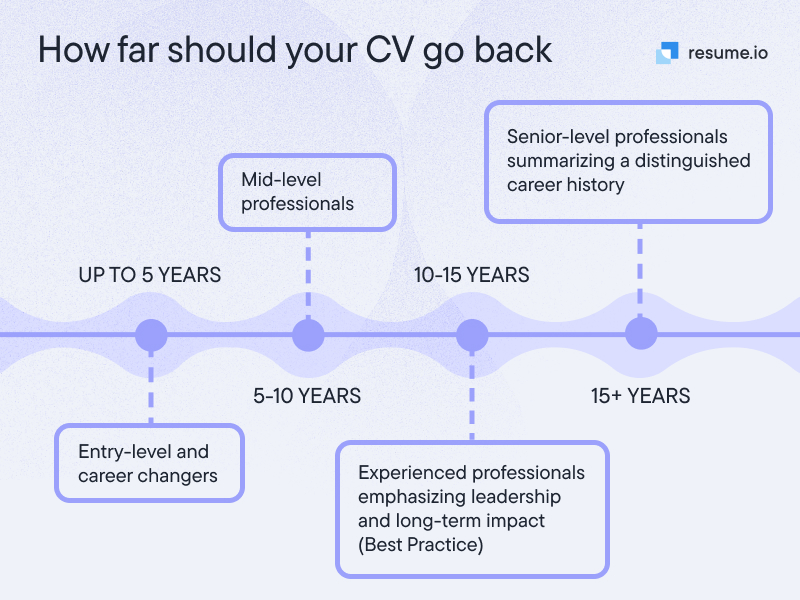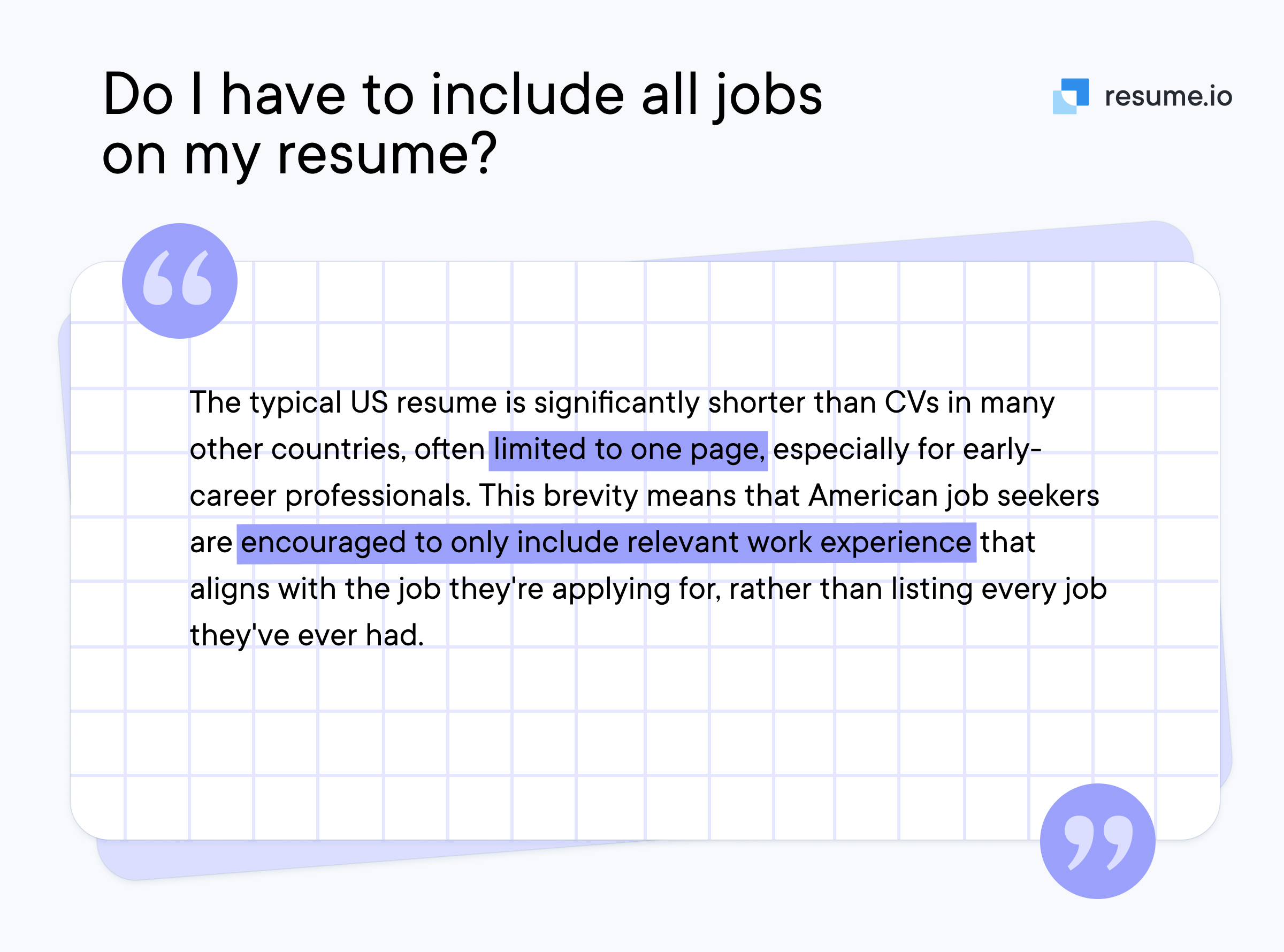It can feel overwhelming to sit down to draft your CV, especially when you have years of work experience to consider. Many people are left with the question of how many jobs to put on their CV. While there aren’t any hard-and-fast rules, we’ll walk you through tips to help you decide which jobs to include and which to leave off.
The goal of a resume is to show off your top skills and accomplishments to make it clear you're the best fit for the role. It takes time and effort, but when you land your dream job it will feel like time well spent. Here, we’ll talk through:
- Including the most relevant jobs
- How to think about short-term positions
- When to include a job that fired you
- How far back you should go
- The right CV format.
If you’re tired of wondering “how many jobs should I put on my CV?” and ready to start writing it, let’s dive in.
Include relevant jobs
While you don’t need to include every job you’ve ever had, you should make sure your CV incorporates the most relevant information for the role you’re applying to. This means that, as much as possible, you should try to tailor your CV to the job you’re applying for— and even the layout can help with that. Our best CV templates are designed to highlight your qualifications clearly while keeping the focus on what matters most to recruiters.
In practice, this means you should include jobs that are related to the job advert or have provided you with relevant skills. For instance, when applying to a job in software development, you should display past software roles on your CV and may include non-technical roles that were at tech companies or helped you understand the end user. You should not, however, take up space with past jobs in food service or warehouse roles.
- Focus on transferable skills
- Show a pattern of growth
- Tailor your CV
- List jobs that are irrelevant to the role you want
- Lie or embellish your experience
If you’re new to the workforce or changing careers, you’ll probably need to include jobs that aren’t perfectly relevant. In that case, focus instead on your transferable skills to make it clear how your past experience will help you in your next role. If you have no or little experience, don’t forget part-time jobs, internships, or volunteer work.
Formatting your CV can be tricky but a messy or disorganised format can slash your chances of getting a call back. Take a look at our article on the best CV format for 2024 and grab some tips to design your CV. We also have advice on how to improve your CV layout. — using a free CV maker can help ensure your design is clean and professional.

Don't feel obligated to include short-term jobs
If your last position didn’t work out as well as you hoped, you may not need to include it on your CV. When a role ends after just a few months, you’re likely left with few bullet points to include, and leaving it on your CV will invite questions about why the role didn’t last. A CV is a marketing document, not an exhaustive list of everything you’ve done in your professional career.
On the other hand, if you’ve done temporary or freelance work that is especially relevant to your desired job — or will account for a long gap in employment — you may want to include it on your CV. If so, be sure to list it as “temporary” or “freelance” so it’s clear the role was intended to be short term.
What about a job where I was fired?
If a job ended up cut short because you were asked to leave, it can be hard to know whether or not to include it on your CV. Unfortunately, there’s no single right answer.
As noted earlier, if the job only lasted a few months, it’s safe to leave it off altogether. However, if it was a long-term job, you’ll want to include it on your CV. Otherwise, you’ll be asked about the gap in work history and you’ll miss out on sharing any experience you gained in that role.
The important thing is to be as positive (or at least neutral) as possible, and never lie. While you don’t need to offer up that you were fired, your best bet is honesty if you’re asked directly why you left. After all, many companies perform reference checks and may find out the true terms of your departure.
Be brief, positive, and share what you learned from the situation or how you approach things differently now. The goal is to maximise attention to what you accomplished in the role, and minimise attention to the way it ended.
Wondering how many jobs should you put on your CV and how that impacts the overall length? We’ve got you covered with our article discussing how long a CV should be.
Focus on the recent past
You may have been working for decades, but there's no need to include all of that time on your CV. Instead, it’s best to list just the last 10 to 15 years of experience. There are a few reasons for this.
One reason to focus only on the past decade or so is that work you did 15+ years ago is probably not as relevant anymore. Technology changes and so do best practices, so focus on what you’ve done recently.
Additionally — and unfortunately — ageism can come into play when a CV goes back too far. You want the reader’s focus to be on your accomplishments and selling points, not on wondering whether they’ll be able to “teach an old dog new tricks.”

Use a reverse chronological CV format
While there are plenty of CV formatting options, your best bet is likely the old standard, the reverse chronological format. This means you put your current or most recent job first, then work your way backwards.
There may be situations where another format makes sense, such as when you are making a career change. Then, you may want to create a section on your CV for “relevant experience” wherein you’ll group experience that is related to your new field of choice. You can also add a section for “other experience” if necessary.
The bottom line
Overall, the choice of what to include on your CV is up to you. You want to strike the right balance between including the most relevant work and avoiding gaps in your work history. It’s also a good idea to focus on concision, keeping your CV to two pages or fewer.
To include roles that are less relevant but still worthy of displaying, consider an “other experience” section or just listing the company, title, and dates without additional bullet points.
Remember that your CV should reflect your accomplishments and achievements so it’s obvious what you’re the best fit for the job. With these tips, you’ll be ready to start applying in no time.
Key takeaways
- Deciding how many jobs to put on your CV takes thought and consideration; there’s no one-size-fits-all answer.
- Focus on the jobs that are relevant to the role to which you’re applying (or roles that have given you transferable skills).
- Feel free to leave off short-term jobs, especially those that are irrelevant, but keep contract or freelance jobs that bulk up your qualifications.
- Use our CV templates to create an interview-winning application now!




